Shocking Spanish flood map shows regions hit by two-week storms that have killed more than 220 people as Malaga is evacuated after new red alert storm warnings
Spain has been ravaged by devastating rain and flooding in the past two weeks, with the wet weather season wreaking havoc on communities along the Mediterranean coast.
A new map lays bare the timeline of where the catastrophic rainfall hit and the deadly flash flooding it caused, as region after region was hit by brutal weather fronts.
The worst impact of heavy rain was felt on October 29, when more than a year’s worth of rainfall was dumped on areas of southern and eastern Spain, with the Valencia region hardest hit, as locals said the warnings were too arrived late.
Flash floods in Valencia and other parts of the country have since killed more than 220 people, destroyed thousands of homes and sparked mass protests against regional authorities.
Extreme weather has gripped large parts of the country this week. Thousands have been evacuated from their homes in the Malaga region and much of the country remains on alert as the stormy weather shows little sign of improving.

Waves crashed onto the promenade of the Ebro Delta Nature Reserve, one of the largest wetlands in the western Mediterranean, during the autumn storm system that devastated Spain
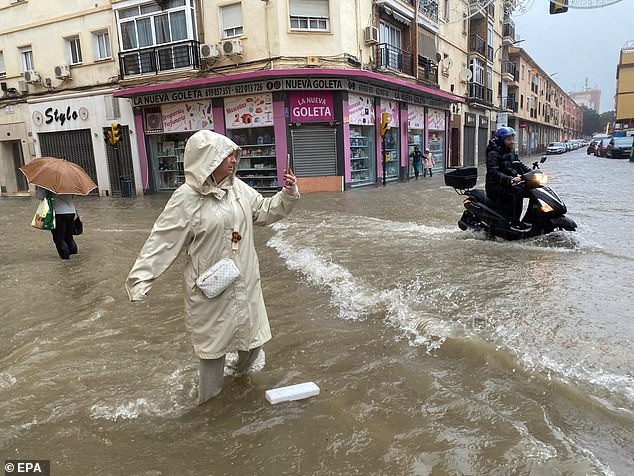
A woman takes a photo of a flooded street in Malaga, Andalusia, Spain, November 13, 2024
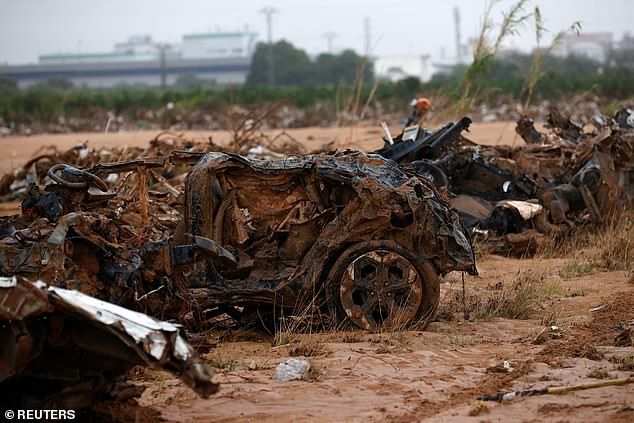
Cars destroyed by the effects of rain are pictured in the Barranco del Poyo in Quart de Poblet, Valencia
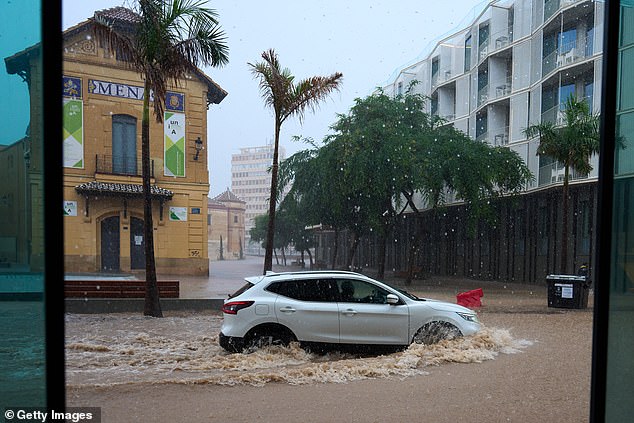
A general view during a heavy rain shower near the El Perchel district on November 13, 2024 in Malaga
A red weather alert was in force for the entire province of Malaga yesterday, with photos and videos showing water rushing through towns and popular coastal resorts including Marbella and Estepona.
Photos from the city of Malaga showed submerged cars and abandoned buses, sticks and other objects piled up at the bottom of streets, which had turned into rivers due to heavy rain.
Meanwhile, Valencia is preparing for another onslaught as coastal areas were placed under high alert on Wednesday night, with forecasters warning up to 180 millimeters (7 inches) of rain could fall within five hours.
More than two weeks after the region first fell victim to the floods, large areas are still covered in mud and debris, while more rainfall makes the situation even more dire for cleanup volunteers and rescue workers, who are still searching in some areas to bodies.
The latest reports show that 223 people were killed, with at least 31 still missing, making it Spain’s deadliest weather disaster in decades.
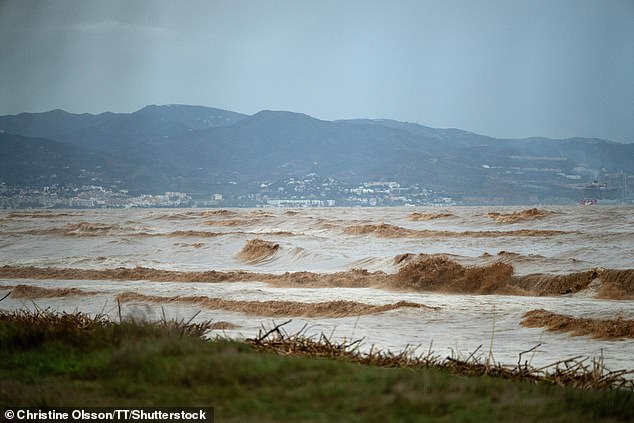
Windy and rainy weather in Malaga in Malaga, Spain November 13

A before and after satellite image shows the flooding in the city of Valencia on October 31
The emergency response included the deployment of more than 2,000 personnel from the Spanish Military Emergency Unit, who carried out rescue and recovery operations together with local aid workers and volunteers.
More than 30,000 more volunteers from across the country have been mobilized to support the ongoing cleanup efforts.
So far, hundreds of families have lost their homes and thousands have had their vehicles destroyed.
Military vehicles patrol the area to provide aid and provide people with food and other necessities.
Numerous homes and public areas were flooded, and up to 155,000 households suffered power outages.
The regions of Aragon, Murcia and Andalusia were also hit by floods on October 29, killing a 71-year-old British ex-pat at his home in Malaga.
While many parts of the country were reeling from the first wave of flooding, the Balearic Islands and Catalonia were warned of heavy rainfall.
Spain’s weather service has issued a red warning for ‘persistent and heavy rainfall’ along the Barcelona coast, warning people to remain alert and not travel ‘unless strictly necessary’.
Roads were blocked by mudslides and high tides, with motorists filmed driving through flooded streets, while Barcelona’s El Prat airport was also closed as the terminal building filled with water.
This week, treacherous conditions continued to affect the nearby area of Tarragona.
Spanish weather service AEMET renewed its warnings yesterday, saying on X that ‘very heavy rain and showers’ would again hit Malaga, Granada, Tarragona and the Valencia coast.
Thousands of people were evacuated from homes and holiday apartments on the Costa del Sol after a weather warning for the area went from yellow to red and locals and holidaymakers were warned of an ‘extreme risk’.
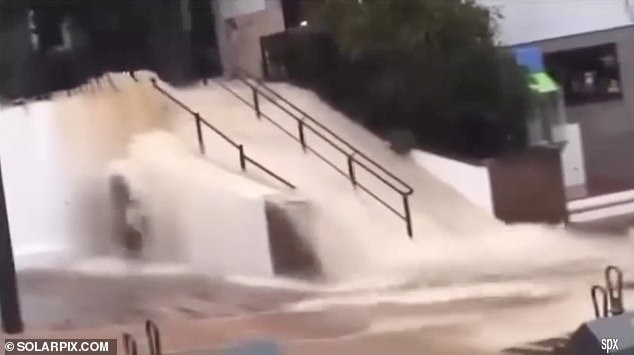
Residents watched as streams of water poured down a staircase within meters of shops and homes
The phenomenon behind the persistent barrage of rain is known locally as DANA, a Spanish acronym for isolated high-altitude depression.
Unlike regular storms or showers, it can form independently of polar or subtropical jet streams.
When cold air blows over the warm waters of the Mediterranean Sea, it causes warmer air to rise quickly, forming towering, dense, water-laden clouds that can linger over the same area for many hours, increasing their destructive potential.
The event sometimes produces large hailstorms and tornadoes, as seen this week, meteorologists say.
Eastern and southern Spain are particularly susceptible to the phenomenon due to its location between the Atlantic Ocean and the Mediterranean Sea.
Warm, moist air masses and cold fronts meet in an area where mountains promote the formation of thunderclouds and rainfall.
Before the term DANA was coined in the early 2000s, any heavy autumn rainfall, characteristic of the Mediterranean climate, was popularly called ‘gota fria’ (cold drop) in Spain and parts of France. The term is still widely used colloquially.
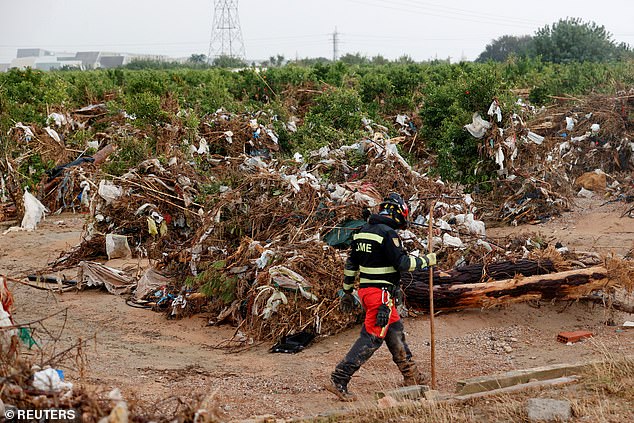
A soldier from the UME Special Emergency Corps searches for bodies after rain and flash floods caused rivers to overflow their banks in Valencia and other parts of Spain, in the Poyo ravine in Quart de Poblet, Valencia, Spain, November 13, 2024
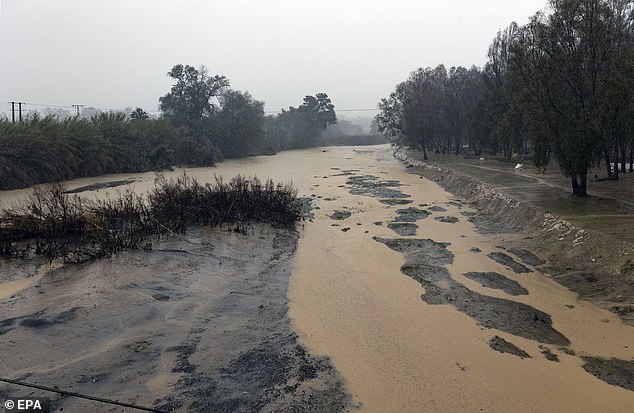
The flooding Guadalhorce River in Cartama, Malaga, Andalusia, Spain, November 13, 2024
Its origins date back to 1886 when German scientists introduced the idea of ’kaltlufttropfen’, or cold air drop, to describe disturbances at high altitudes, but without any obvious reflection on the surface.
Aemet says the cold drop concept is outdated and defines DANA as a closed depression at high altitude that has become isolated and separated from an associated jet stream.
Aemet says DANAs sometimes stand still or even move backward, from east to west.
Enrico Scoccimarro, a senior scientist at the Euro-Mediterranean Center for Climate Change, said last month that while the large water dumps are “typical for the western Mediterranean and for this period of the year”, the recent weather conditions were “exceptional”.
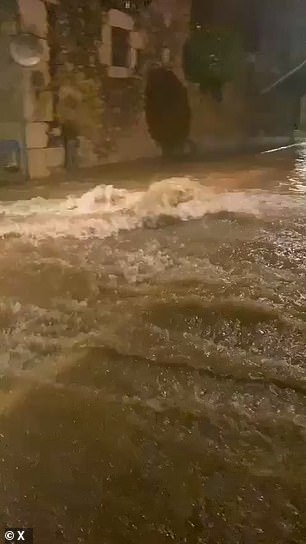
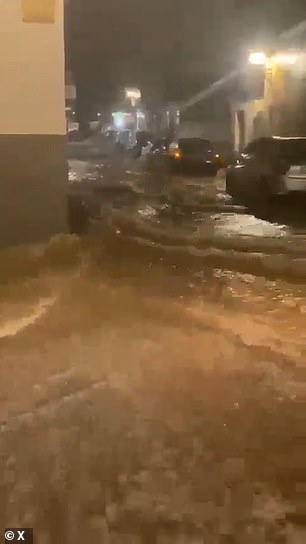
Shocking images shared on social media overnight showed the deluge pouring through the streets of Alcanar
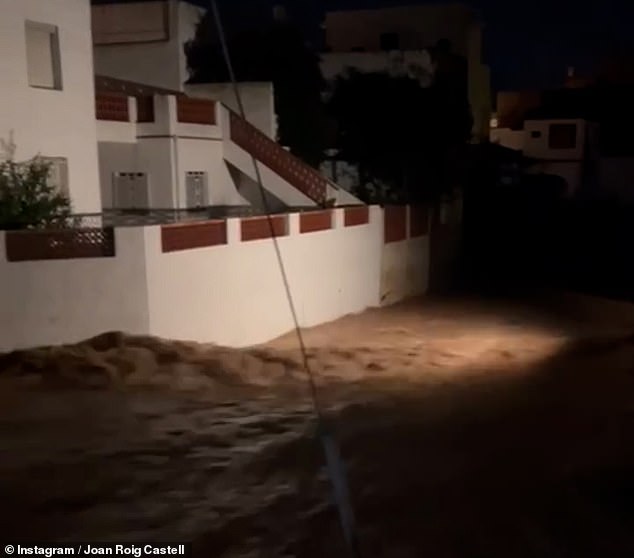
Floodwaters flow past houses in southeastern Spain
‘Events of this type, in these areas and with this intensity, have not been recorded for decades. You have to go back to the 1960s to find comparable values,” he told Italian daily Corriere della Sera.
Scientists are typically cautious about linking individual weather events to climate change, but many have said that a combination of linked factors likely caused the dramatic weather event.
Dr. Friederike Otto, head of World Weather Attribution at the Center for Environmental Policy, Imperial College London, said: ‘There is no doubt that these explosive downpours were amplified by climate change.
‘With every fraction of a degree of global warming, the atmosphere can retain more moisture, leading to heavier rainfall.
“These deadly floods are yet another reminder of how dangerous climate change has become at just 1.3°C of warming.
‘But last week the UN warned that we are on track to experience 3.1°C of warming by the end of the century.’
Dr. Jess Neumann, Associate Professor of Hydrology at the University of Reading, added: ‘The flash floods in Spain are another terrible reminder of the changing and more chaotic weather we are experiencing as a result of climate change.’
Research has shown that the Mediterranean region – where more than 510 million people live – is warming 20 percent faster than the global average.
This puts coastal areas at increased risk of disasters, including flooding and erosion.
Dr. Ernesto Rodríguez Camino, senior state meteorologist and member of the Spanish Meteorological Association, said: ‘What we know in general terms is that, in the context of climate change, this type of intense and exceptional, rare rainfall will become more and more frequent. more frequent and intense and therefore more destructive.’
The UN Environment Program calls the Mediterranean a ‘climate change hotspot’ where vulnerabilities are increasing.
